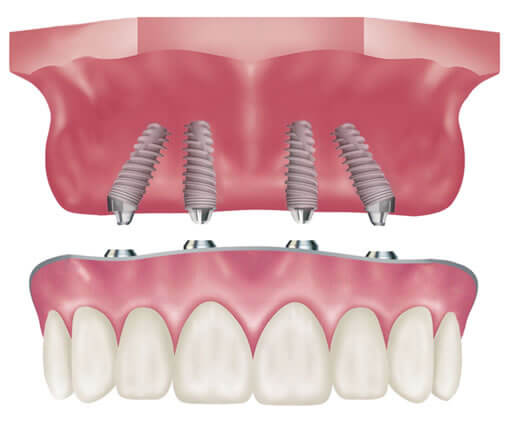All-on-four concept
New implant technology has gained popularity since last few decades, known as all-on-four implant technology. This technique was first implemented for implant-denture rehabilitation by Malo in 2003, which is now currently being used for full arch edentulism cases.
The all‑on‑four implant technique is basically an implant design that is useful in severely resorbed ridges including both completely edentulous maxilla and mandible.
In the all‑on‑four concept, the abutment is designed as a screw‑retained fixed prostheses for full-arch, prepared on a total of four implants.
Out of these four implants, two are placed in the anterior region, orthogonally to the occlusal plane, and other two in the posterior region with an angulation of 15‑45° distally, for both the edentulous maxillary and/or mandibular arches.
It was developed to promote immediate functions, and prevent surgical regenerative procedures that may lead to financial burden and cause risks and complications, commonly encountered with such procedures.

Advantages
- Anatomical structures are avoided by using angled/tilted implants in the posterior region
- Longer implants can be anchored in dense bone by making use of angled posterior implants
- Demonstrates high success rate (>92% success)
- Does not require placement of bone grafts in the edentulous maxillary and mandibular arch.
- Sufficient space between the implants makes it easier to clean and maintains good biomechanics.
- Allows immediate function and aesthetics
- Both fixed and removable prosthesis can be used as final restoration.
Clinical significance
The “all-on-four/six” concept allows best possible use of the load-bearing regions of the jawbone. Due to the freedom of tilting associated with these implants, they can be anchored in bone structures with appropriate density, such as the anterior regions.
It allows adequate anterior-posterior spread, providing a strong prosthetic framework. As there are four/six implants, therefore they allow appropriate space without coming into conflict with other implants. This modality of making use of few implants with angulation has demonstrated better results in previous studies.
Current perspective
Studies have shown that effective placement of four-six implants allow adequate distribution of
load on the alveolar crest and vital anatomical structures are also avoided (mandibular nerve, maxillary sinus. Literature reports a high survival rate of implants with this method, ranging between 92.2 and 100%. This treatment allows immediate function and makes best use of the available bone.